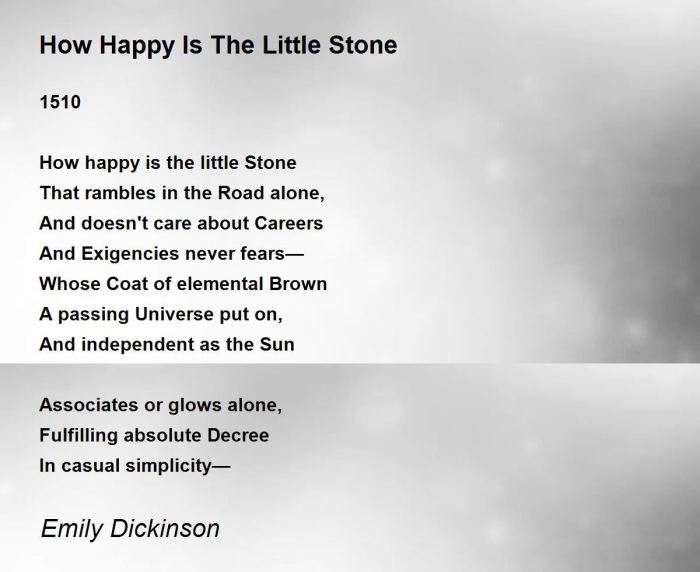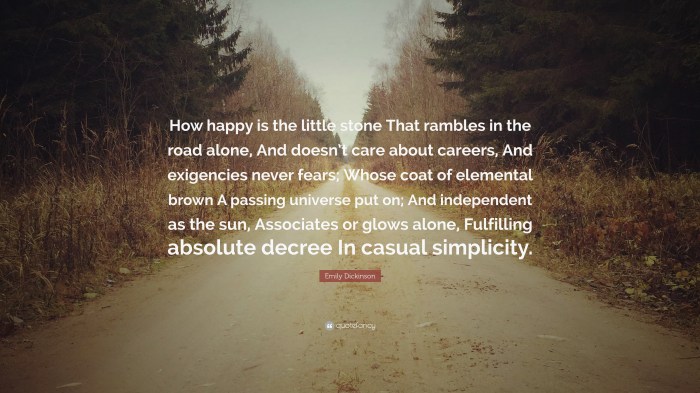How happy is the little stone by emily dickinson – Emily Dickinson’s enigmatic poem “How Happy Is the Little Stone” invites readers to contemplate the profound themes of nature, mortality, and the elusive nature of happiness. With its evocative imagery and insightful language, the poem offers a unique perspective on the human condition, inviting us to question our own place within the vast tapestry of existence.
Through a careful examination of the poem’s symbolism, language, and critical reception, this analysis delves into the complexities of Dickinson’s work, revealing its enduring relevance and timeless appeal.
Introduction: How Happy Is The Little Stone By Emily Dickinson

Emily Dickinson’s “How Happy is the Little Stone” is a contemplative poem that explores themes of happiness, mortality, and the search for meaning in life. The poem’s simple yet evocative language and imagery create a vivid picture of a stone’s existence, contrasting it with the complex emotions and experiences of human beings.
The poem begins with a description of the stone’s contentment: “How happy is the little stone/That rambles in the road alone,/And doesn’t care for wind or cold,/And in the mud lies warm and bold!” This initial stanza establishes the poem’s central contrast between the stone’s carefree existence and the often-turbulent nature of human life.
Symbolism and Imagery
The stone in the poem serves as a powerful symbol of stability and resilience. Its ability to withstand the elements and find contentment in solitude suggests a level of inner peace and self-sufficiency that humans often struggle to achieve. The contrast between the stone’s simple existence and the complex emotions of the speaker highlights the challenges and complexities of human experience.
The poem’s imagery also contributes to its symbolic meaning. The “wind and cold” represent the challenges and hardships that humans face, while the “mud” represents the messy and often-difficult nature of life. The stone’s ability to remain “warm and bold” in the face of these challenges suggests that inner strength and resilience can provide a foundation for happiness even in the midst of adversity.
Nature and the Human Condition, How happy is the little stone by emily dickinson
The poem’s depiction of nature reflects on the relationship between the human condition and the natural world. The stone’s contentment in its natural surroundings suggests that humans may find solace and meaning in connecting with nature. The poem also explores the theme of mortality, as the stone’s existence is contrasted with the brevity of human life.
The stone’s permanence reminds the speaker of the fleeting nature of human existence, prompting them to question the significance of their own experiences.
Language and Form
Dickinson’s use of language in the poem is simple yet effective. The short, concise lines and simple vocabulary create a sense of immediacy and authenticity. The use of repetition, such as the phrase “How happy is the little stone,” emphasizes the poem’s central theme of contentment.
The poem’s irregular rhyme scheme adds to its conversational tone, making it feel like a personal reflection rather than a formal composition.
Critical Reception and Legacy
Emily Dickinson’s “How Happy is the Little Stone” has received critical acclaim for its insightful exploration of happiness, mortality, and the human condition. The poem has been praised for its evocative imagery, simple yet powerful language, and its ability to resonate with readers on a personal level.
Critics have also noted the poem’s enduring legacy as a timeless reflection on the search for meaning in life.
Quick FAQs
What is the main theme of “How Happy Is the Little Stone”?
The poem explores the themes of nature, mortality, and the search for meaning, examining the human condition through the lens of a seemingly inanimate object.
How does Dickinson use symbolism in the poem?
Dickinson employs various symbols, such as the stone, the bird, and the grass, to represent different aspects of the human experience and the natural world.
What is the significance of the poem’s language and form?
Dickinson’s use of concise language, unconventional punctuation, and irregular rhyme scheme contributes to the poem’s unique and thought-provoking nature.


